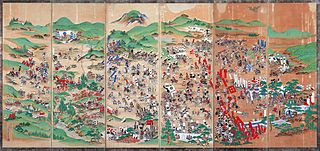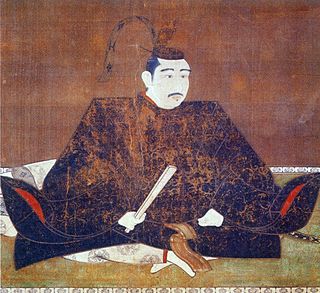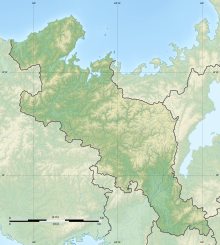
The Battle of Sekigahara was a historical battle in Japan which occured on October 21, 1600 in what is now Gifu Prefecture, Japan, at the end of the Sengoku period.

Tokugawa Hidetada was the second shōgun of the Tokugawa dynasty, who ruled from 1605 until his abdication in 1623. He was the third son of Tokugawa Ieyasu, the first shōgun of the Tokugawa shogunate.

Ishida Mitsunari was a Japanese samurai and military commander of the late Sengoku period of Japan. He is probably best remembered as the commander of the Western army in the Battle of Sekigahara following the Azuchi–Momoyama period of the 16th century. He is also known by his court title, Jibu-no-shō (治部少輔).

Maeda Toshinaga was a Sengoku period Japanese samurai and the second early-Edo period daimyō of Kaga Domain in the Hokuriku region of Japan, and the 3rd hereditary chieftain of the Maeda clan. He was the eldest son of Maeda Toshiie. His childhood name was "Inuchiyo" (犬千代).

Akechi Tama, usually referred to as Hosokawa Gracia, was a member of the aristocratic Akechi family from the Sengoku period. Gracia is best known for her role in the Battle of Sekigahara; she was considered to be a political hostage to the Western army led by Ishida Mitsunari. She retracted from committing suicide (seppuku) because of her Catholic faith, breaking the code of conduct imposed on women of the samurai class.

Katō Yoshiaki was a Japanese daimyō of the late Sengoku period to early Edo period who served as lord of the Aizu Domain. A retainer of Toyotomi Hideyoshi, he fought in the battle of Shizugatake in 1583, and soon became known as one of the shichi-hon-yari (七本槍), or Seven Spears of Shizugatake.

Fukushima Masanori was a Japanese daimyō of the late Sengoku period to early Edo period who served as lord of the Hiroshima Domain. A retainer of Toyotomi Hideyoshi, he fought in the Battle of Shizugatake in 1583, and soon became known as one of Seven Spears of Shizugatake which also included Katō Kiyomasa and others.

Kuroda Nagamasa was a daimyō during the late Azuchi–Momoyama and early Edo periods. He was the son of Kuroda Kanbei, Toyotomi Hideyoshi's chief strategist and adviser.
The Sekigahara Campaign was a series of battles in Japan fought between the Eastern Army aligned with Tokugawa Ieyasu and the Western Army loyal to Ishida Mitsunari, culminating in the decisive Battle of Sekigahara. The conflict was sparked by a punitive expedition led by Ieyasu against the Uesugi clan in the northeastern Tōhoku region, providing Mitsunari with an opportunity to denounce Ieyasu in the name of the infant ruling taikō Toyotomi Hideyori while the Tokugawa troops were in the field.

Hosokawa Tadaoki was a Japanese samurai warrior of the late Sengoku period and early Edo period. He was the son of Hosokawa Fujitaka with Numata Jakō, and he was the husband of a famous Christian convert (Kirishitan), Hosokawa Gracia. For most of his life, he went under the name of Nagaoka Tadaoki that had been adopted by his father and was related to a town that was in their domain. Shortly after the victory at Sekigahara, Nagaoka Tadaoki reverted to his original name Hosokawa Tadaoki.

Shima Kiyooki, also known as Shima Tomoyuki and Shima Katsutake, was a Japanese samurai of the late Sengoku period. His nickname was Shima Sakon. Sakon eventually left the service of the Hatakeyama clan, Tsutsui Junkei, Toyotomi Hidenaga and eventually joined and serve under Ishida Mitsunari.

Hosokawa Fujitaka, also known as Hosokawa Yūsai, was a Japanese samurai daimyō of the Sengoku period. Fujitaka was a prominent retainer of Ashikaga Yoshiaki, the last Ashikaga shōgun. When he joined the Oda, Oda Nobunaga rewarded him with the fief of Tango and went on to become one of the Oda clan's senior generals.

Kokura Domain was a feudal domain under the Tokugawa shogunate of Edo period Japan, in what is now eastern Fukuoka Prefecture. It was centered around Kokura Castle in what is now Kitakyushu, Fukuoka and was ruled by the fudai daimyō Ogasawara clan for much of its history. In the Bakumatsu period and first years of the Meiji period, it was briefly known as Kawara Domain (香春藩) and then Toyotsu Domain (豊津藩).

Ikeda Terumasa was a Japanese daimyō of the early Edo period. His court title was Musashi no Kami. Terumasa was also known by the nickname saigoku no shōgun, or, "The Shōgun of Western Japan". Terumasa fought in many of the battles of the late Azuchi–Momoyama period, and due to his service at the Battle of Sekigahara, received a fief at Himeji. His childhood name was Araokojimaru (荒尾古新丸). He was the son of Ikeda Tsuneoki and brother of Ikeda Sen.

Maeda Matsu (前田まつ), also known as Omatsu no Kata (お松の方) (1547–1617), was a Japanese noble lady and aristocrat of the 16th century. She was the wife of Maeda Toshiie, who founded the Kaga Domain. Matsu had a reputation for intelligence; she was skilled at both literary and martial arts, she fought alongside her clan. Known for her fierce determination, Matsu was vitally important to the success of the Maeda clan, being at the forefront of many political and diplomatic issues. She was eternalized for saving the Maeda clan from Tokugawa Ieyasu in Battle of Sekigahara and Siege of Osaka.

Numata Jakō also known as Hosokawa Maria was a Japanese noble lady of the Sengoku period. She was the wife of Hosokawa Fujitaka and mother of Hosokawa Tadaoki. She was best known for fighting and for accompanying Hosokawa Fujitaka in the siege of Tanabe during Sekigahara Campaign.

Tango-Tanabe Domain was a feudal domain under the Tokugawa shogunate of Edo period Japan, located in Tango Province in what is now the northern portion of modern-day Kyoto Prefecture. It was centered around Tanabe Castle, also known as Maizuru Castle which was located in what is now the city of Maizuru, Kyoto. The area of Tango-Tanabe Domain covered the entire area of Kasa County, and corresponds to the current area of the city of Maizuru, and parts of Yura, Miyazu, and Fukuchiyama.

Miyazu Castle is a flatland-style Japanese castle located in Miyazu, northern Kyoto Prefecture, Japan. At the end of the Edo period, Miyazu Castle was home to a branch of the Honjō-Matsudaira, daimyō of Miyazu Domain.

Tanabe Castle is a flatland-style Japanese castle located in Maizuru, northern Kyoto Prefecture, Japan. At the end of the Edo period, Tanabe Castle was home to a branch of the Makino, daimyō of Tango-Tanabe Domain. The castle was nicknamed Maizuru Castle, and during the early Meiji period, the city was named "Maizuru" to avoid confusion with the city in southern Kyoto now known as Kyōtanabe.
Maeda Chiyo (前田千世) or Shunkō-in was a Japanese noble woman from the Sengoku period. She was from the samurai-class Maeda clan, her father was Maeda Toshiie and her mother was Maeda Matsu. Chiyo was first married to Hosokawa Tadataka, and later to Murai Nagatsugu.



















